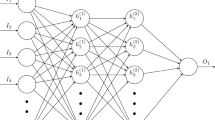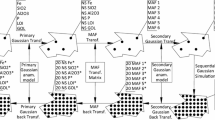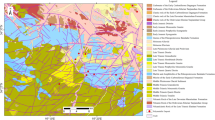Abstract
Mine design, mine production planning and the economic evaluation of multivariate ore deposits are based on the mineral resources that are recoverable after applying cutoffs to the grades of selective mining units. Being able to reliably assess the recoverable resource uncertainty of more than one element is key for the economic evaluation of mining projects. Multivariate geostatistical models are difficult to fit and strongly influence the resources reported. The proposed approach avoids the delicate modeling step by directly estimating multivariate tonnages and their associated confidence intervals from a reduced set of features extracted from data. The predictive models are obtained by training with conditional simulations. For each case considered in the training phase, the coregionalization parameters are drawn randomly from within specified intervals and multiple realizations make it possible to obtain deposits conditional to the simulated data sets. Multiple linear regression training is carried out using input–output data to generate predictive models that relate the input variables calculated from the simulated data sets and the output variables (i.e., mean tonnage and tonnage quantiles) computed from the simulated deposits. The results from a synthetic bivariate case indicate excellent tonnage prediction and credible uncertainty quantification. A lateritic nickel deposit subject to a constraint on the maximum silica/magnesia ratio shows the applicability of this approach in a real-world context. The resulting tonnage surface and the associated uncertainty quantification provide an essential tool to help assess the economic value of the mine project.











Similar content being viewed by others
Availability of data and materials
The datasets generated and analysed during the current study are not publicly available due to confidentiality reasons but are available from the corresponding author on reasonable request.
Code availability
There is no available public code.
References
Barnett, R. M., Manchuk, J. G., & Deutsch, C. V. (2014). Projection pursuit multivariate transform. Mathematical Geosciences, 46, 337–359.
Battalgazy, N., & Madani, N. (2019). Categorization of mineral resources based on different geostatistical simulation algorithms: A case study from an iron ore deposit. Natural Resources Research, 28, 1329–1351.
Bérubé, C. L., Olivo, G. R., Chouteau, M., Perrouty, S., Shamsipour, P., Enkin, R. J., Morris, W. A., Feltrin, L., & Thiémonge, R. (2018). Predicting rock type and detecting hydrothermal alteration using machine learning and petrophysical properties of the Canadian Malartic ore and host rocks, Pontiac Subprovince, Québec, Canada. Ore Geology Reviews, 96, 130–145.
Boucher, A., & Dimitrakopoulos, R. (2012). Multivariate block-support simulation of the Yandi iron ore deposit, Western Australia. Mathematical Geosciences, 44, 449–468.
Brooker, P. I. (1985). Two-dimensional simulation by turning bands. Mathematical Geology, 17, 81–90.
Desbarats, A. J., & Dimitrakopoulos, R. (2000). Geostatistical simulation of regionalized pore-size distributions using min/max autocorrelation factors. Mathematical Geology, 32, 919–942.
Dhaher, G. M., & Lee, M. H. (2013). A comparison between the performance of kriging and cokriging in spatial estimation with application. Matematika: Malaysian Journal of Industrial and Applied Mathematics, 33–41.
Dominy, S., Noppè, M., & Annels, A. (2002). Errors and uncertainty in mineral resource and ore reserve estimation: The importance of getting it right. Exploration and Mining Geology, 11, 77–98.
Emery, X., & Alegría, A. (2021). The Gauss hypergeometric covariance kernel for modeling second-order stationary random fields in euclidean spaces: Its compact support, properties and spectral representation. arXiv:2101.09558.
Emery, X., Arroyo, D., & Mery, N. (2021). Twenty-two families of multivariate covariance kernels on spheres, with their spectral representations and sufficient validity conditions. Stochastic Environmental Research and Risk Assessment.
Emery, X., & Lantuéjoul, C. (2006). TBSIM: A computer program for conditional simulation of three-dimensional gaussian random fields via the turning bands method. Computers & Geosciences, 32, 1615–1628.
Emery, X., Porcu, E., & White, P. (2021). Flexible validity conditions for the multivariate Matérn covariance in any spatial dimension and for any number of components. arXiv e-prints arXiv:2101.04235.
Eze, P. N., Madani, N., & Adoko, A. C. (2019). Multivariate mapping of heavy metals spatial contamination in a Cu-Ni exploration field (Botswana) using turning bands co-simulation algorithm. Natural Resources Research, 28, 109–124.
Faria, P. H., Costa, J. F. C. L., & Bassani, M. A. A. (2021). Multivariate geostatistical simulation with PPMT: an application for uncertainty measurement. Applied Earth Science, 130, 174–184.
Ghezelbash, R., Maghsoudi, A., Bigdeli, A., & Carranza, E. J. M. (2021). Regional-scale mineral prospectivity mapping: Support vector machines and an improved data-driven multi-criteria decision-making technique. Natural Resources Research, 30, 1977–2005.
Goovaerts, P. (1993). Spatial orthogonality of the principal components computed from coregionalized variables. Mathematical Geology, 25, 281–302.
Granian, H., Tabatabaei, S. H., Asadi, H. H., & Carranza, E. J. M. (2015). Multivariate regression analysis of lithogeochemical data to model subsurface mineralization: a case study from the Sari Gunay epithermal gold deposit, NW Iran. Journal of Geochemical Exploration, 148, 249–258.
Hosseini, S., Asghari, O., & Emery, X. (2017). Direct block-support simulation of grades in multi-element deposits: application to recoverable mineral resource estimation at Sungun porphyry copper-molybdenum deposit. Journal of the Southern African Institute of Mining and Metallurgy, 117, 577–585.
Kalam, S., Khan, R. A., Khan, S., Faizan, M., Amin, M., Ajaib, R., & Abu-Khamsin, S. A. (2021). Data-driven modeling approach to predict the recovery performance of low-salinity waterfloods. Natural Resources Research, 30, 1697–1717.
Karbalaei Ramezanali, A., Feizi, F., Jafarirad, A., & Lotfi, M. (2020). Geochemical anomaly and mineral prospectivity mapping for vein-type copper mineralization, Kuhsiah-e-Urmak area, Iran: Application of sequential gaussian simulation and multivariate regression analysis. Natural Resources Research, 29, 41–70.
Keskinkilic, E. (2019). Nickel laterite smelting processes and some examples of recent possible modifications to the conventional route. Metals, 9.
Leuangthong, O., & Deutsch, C. V. (2003). Stepwise conditional transformation for simulation of multiple variables. Mathematical Geology, 35, 155–173.
McKay, G., & Harris, J. (2015). Comparison of the data-driven random forests model and a knowledge-driven method for mineral prospectivity mapping: A case study for gold deposits around the Huritz Group and Nueltin Suite, Nunavut, Canada. Natural Resources Research, 25.
Mery, N., & Marcotte, D. (2021). Quantifying mineral resources and their uncertainty using two existing machine learning methods. Mathematical Geosciences.
Mery, N., Marcotte, D., & Dutaut, R. (2020). Constrained kriging: An alternative to predict global recoverable resources. Natural Resources Research, 29, 2275–2289.
Minnitt, R., & Deutsch, C. (2014). Cokriging for optimal mineral resource estimates in mining operations. Journal of the Southern African Institute of Mining and Metallurgy, 114, 189–203.
Montoya, C., Emery, X., Rubio, E., & Wiertz, J. (2012). Multivariate resource modelling for assessing uncertainty in mine design and mine planning. Journal of the Southern African Institute of Mining and Metallurgy, 112, 353–363.
O’Brien, J. J., Spry, P. G., Nettleton, D., Xu, R., & Teale, G. S. (2015). Using random forests to distinguish gahnite compositions as an exploration guide to Broken Hill-type Pb-Zn-Ag deposits in the Broken Hill domain, Australia. Journal of Geochemical Exploration, 149, 74–86.
Pan, G., Gaard, D., Moss, K., & Heiner, T. (1993). A comparison between cokriging and ordinary kriging: Case study with a polymetallic deposit. Mathematical Geology, 25, 377–398.
Sagadin, C., Luidold, S., Wagner, C., & Wenzl, C. (2016). Melting behaviour of ferronickel slags. JOM, 68, 3022–3028.
Tercan, A., & Sohrabian, B. (2013). Multivariate geostatistical simulation of coal quality data by independent components. International Journal of Coal Geology, 112, 53–66. Special issue on geostatistical and spatiotemporal modeling of coal resources.
van den Boogaart, K. G., Mueller, U., & Tolosana-Delgado, R. (2017). An affine equivariant multivariate normal score transform for compositional data. Mathematical Geosciences, 49, 231–251.
Vergara, D., & Emery, X. (2013). Conditional bias for multivariate resources estimation. In J. Ambrus, J. Beniscelli, F. Brunner, J. Cabello, & F. Ibarra (Eds.), 3rd International seminar on geology for the mining industry (pp. 27–33).
Yalçin, E. (2005). Cokriging and its effect on the estimation precision. Journal of The South African Institute of Mining and Metallurgy, 105, 223–228.
Zhang, S., Carranza, E. J. M., Xiao, K., Wei, H., Yang, F., Chen, Z., Li, N., & Xiang, J. (2021a). Mineral prospectivity mapping based on isolation forest and random forest: Implication for the existence of spatial signature of mineralization in outliers. Natural Resources Research.
Zhang, S. E., Nwaila, G. T., Tolmay, L., Frimmel, H. E., & Bourdeau, J. E. (2021b). Integration of machine learning algorithms with Gompertz curves and Kriging to estimate resources in gold deposits. Natural Resources Research, 30, 39–56.
Acknowledgments
This research was funded by the National Agency for Research and Development of Chile (ANID) through the Doctorado Becas Chile program (Grant Number 72180581), the National Research Council of Canada (Grant RGPIN-2015-06653), Quebec’s Merit Scholarship Program for Foreign Students (PBEEE, Grant Number 0000274857) and Polytechnique Montréal’s Doctoral Scholarship Program.
Author information
Authors and Affiliations
Contributions
Nadia Mery: Study conception, outlining and carrying out the experiments and analysis. Denis Marcotte: Study conception and supervise the research. The first draft was written by Nadia Mery, and subsequent versions were reviewed by Denis Marcotte. Both authors read and approved the final manuscript.
Corresponding author
Ethics declarations
Conflict of Interest
The authors declare that they have no known competing financial interests or personal relationships that could have appeared to influence the work presented in this manuscript.
Rights and permissions
About this article
Cite this article
Mery, N., Marcotte, D. Assessment of Recoverable Resource Uncertainty in Multivariate Deposits Through a Simple Machine Learning Technique Trained Using Geostatistical Simulations. Nat Resour Res 31, 767–783 (2022). https://doi.org/10.1007/s11053-022-10028-9
Received:
Accepted:
Published:
Issue Date:
DOI: https://doi.org/10.1007/s11053-022-10028-9




